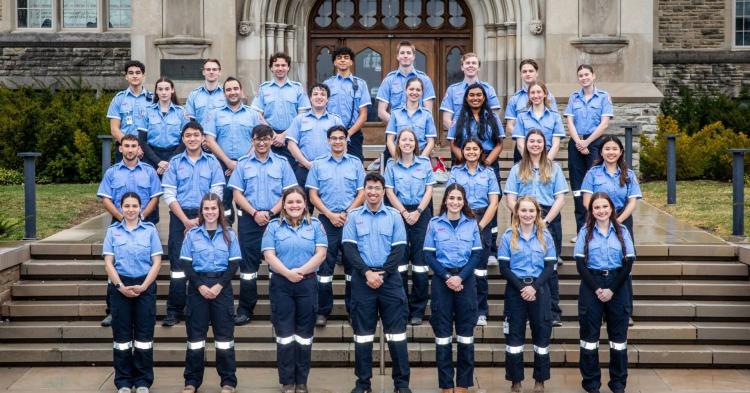
Some members of the 2023-24 Western Student Emergency Response Team gather outside University College on March 26, 2024. (Christopher Kindratsky/Western Communications)
Back in 1987, first-year Western student Robert Garland had his sights set on teachers college and his eyes on the road, biking to all his classes.
"Riding back and forth across campus, I would come across medical emergencies, from car accidents to sport injuries or seizures," Garland said.
And he always stopped to help.
"I had a lifeguarding background and a minimal amount of medical training, but enough to render first aid. When further medical assistance was required, I was always surprised by how long it took for an ambulance to arrive and make patient contact."
Garland took the initiative to change that, imagining a student-led emergency response team like the one at McMaster University in Hamilton, Ont., would cut response times, benefiting the campus community and local emergency responders.
It took time, and what he now calls "a combination of tenacity and chance encounters," but in 1989, as part of the 28th Brigade of St. John Ambulance and with then Student Health Services director Dr. Tom Macfarlane as its champion, Western's Student Emergency Response Team was born.
Garland became SERT's first program director. The experience was life-changing, prompting him to forgo teachers college to become a paramedic, and later pursue a 30-year career as a police officer.
He stands among hundreds of proud SERT alumni and is one of many returning to campus April 6 to celebrate the organization's 35th anniversary.
Humble beginnings, happenstance heroes

Robert Garland, SERT co-founder and first SERT program director. (Submitted)
In order to establish a student emergency response team on campus, Garland knew he'd need more than anecdotal observations to get buy-in from Western and community stakeholders.
In 1988, the University Students' Council (USC) endorsed his plan and he recruited a team of eight undergraduate students to conduct a case study, compiling data from Campus Community Police (now Western Special Constable Service), to document the frequency of emergency and first aid situations and the challenges affecting the response times.
He presented the findings to the directors of Student and Health Services, Campus Police and the director of emergency services at University Hospital (UH), making a pitch for an on-site, student-led, 24-hour first aid team.
"The proposal was well received but not endorsed," Garland said.
But the compelling evidence secured enthusiastic support from Dr. Macfarlane and led to a major milestone: Creating a direct line of communication from London, Ont.'s central ambulance communications centre to Campus Police.
Previously, ambulances responded to calls on campus, searching for a building, floor or room number.
"This was definitely tacking on to their response times," Garland said. "Instead of responding within four to six minutes, it was taking from eight to 16 minutes for patient contact."
The new system alerted Campus Police to the nature of the emergency, with one officer dispatched to the scene and another sent to escort ambulances through the closest entrance.
With Macfarlane's encouragement, Garland and the case study team stayed the course, developing a modified proposal for a daytime first aid team. (It would be 10 years before the team would operate 24/7.)
In the fall of 1989, during orientation, the USC organized a large concert on UC hill. It drew thousands of people, including Garland.
He was close by when a student fell into respiratory arrest.
"I initiated resuscitation before she was transported to UH and she survived," he said.
A shaken team of USC organizers, realizing the need for on-site medical assistance, approached Garland on the spot, asking him to put a team together to provide special event first aid coverage for the rest of the week.
Garland agreed, with less than 24 hours to prepare.
"Fortunately, the members of my case study group were in nursing and had all the essential first aid and CPR qualifications," he said. "We met very early that next morning and divvied up responsibilities."
Using fabric paint, they quickly turned white T-shirts into uniforms and their handmade signs transformed a white jeep into a mobile first aid station.











